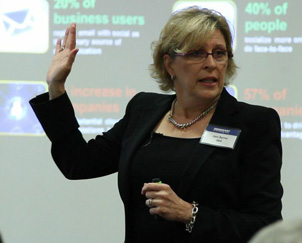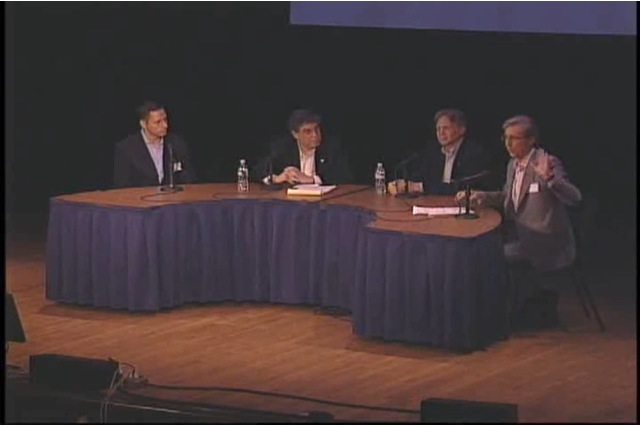IBM’s Dr. Jani Byrne joins MiniTrends 2014 (Sept 26) – Special $150 rate ends Noon Monday Sept 22
September 19, 2014

Dr. Jani Byrne
Director of Marketing, Cloud, IBM
We are delighted that Dr. Jani Byrne, Director of Marketing, Cloud, at IBM has joined the program for our 3rd annual MiniTrends 2014: Insight, Innovation & Strategy. Jani will be sharing her experiences as corporate innovator in her talk “Musings of a Wild Duck in a Big Pond.”
Jani is responsible for Content Marketing globally for Cloud, one of IBMs leading strategic initiatives, creating and distributing consumable, relevant content to drive client acquisition and purchase. Previously she served as IBM’s Director, Marketing Strategy for Global Mid-Markets MSPs and Director, Strategy.
Jani is on the Boards of The Seton Fund at the Seton Family of Hospitals’ and Austin Chamber of Commerce Technology Partnership.
Register Now for special price for full conference of only $150 until noon, Monday, September 22.
Our Keynotes are Austin Tech Leader and Bazaarvoice Founder Brett Hurt, top D.C. Futurist David Pearce Snyder, and award-winning author Dr. John Vanston. Also headlining is USA TODAY’s Road Warrior of the Year Joyce Gioia.
 We have an excellent applications panel on how to turbo-charge your success and profit by combining MiniTrends methods with your innovation strategy. Panelists include Raj Asava, Jeffrey Fry, Steve Pearson, Carrie Vanston, and Larry Vanston.
We have an excellent applications panel on how to turbo-charge your success and profit by combining MiniTrends methods with your innovation strategy. Panelists include Raj Asava, Jeffrey Fry, Steve Pearson, Carrie Vanston, and Larry Vanston.
The breadth and depth of the speaking talent and schedule for this awesome event it exceptional. In addition we have incredible attendees who are thought-leaders in their own right. (See what our past attendees say.) We hope you, too, will be part of the this year’s amazing event.
MiniTrends 2014: Insight, Innovation & Strategy.
Friday, September 26, 2014
8:30 am – 5:30 pm followed by “Power Hour” Reception
Holiday Inn Lady Bird Lake, Austin, TX
Full Conference for Only $150
(Special ends Noon, Monday, Sept. 22)
All attendees receive Continental Breakfast, Breaks,
and Lunch followed by a Networking Reception!
Please share offer with your friends, colleagues & networks.
9 Futurists Give 2020 Digital World Predictions to Mashable
July 11, 2012

9 Futurists give Mashable's Amy-Mae Elliott predictions for the digital future. Image courtesy of S58y. Used under Creative Commons license, http://creativecommons.org/licenses/by/2.0/deed.en.
We’re always interested in predictions for the future and were excited to be asked by Mashable’s Amy-Mae Elliott for one of our own in her article “9 Bold Predictions for the Digital World of 2020.” Dr. John Vanston chimed in on how voice quality by 2020 will be so excellent that “Younger generations will hear something that theretofore only older generations remember: the sound of a pin dropping.”
A couple of the futurists’ comments in the Mashable article refer to the massive amounts of information that is increasingly available to everyone. According to Dave Evans, Cisco Chief Futurist, “We are amassing unprecedented amounts of data – a zettabyte alone this year. This data is social and public (Facebook, Twitter, YouTube, blogs, etc.). Billions of devices (25-50 billion by 2020) will contribute exponentially to this avalanche of data … By 2015, Cisco Visual Networking Index predicts 1 million video minutes will traverse the Internet every second.”
According to Brian David Johnson, Futurist, Intel, “the size of the meaningful computational power keeps getting smaller and smaller. So, as we approach 2020 the size of the intelligent gets closer to zero in size, nearly invisible.”
Those that can use these massive amounts of information most imaginatively will have a very real advantage in the coming years. A good way to winnow through the information is finding minitrends in your areas of interest within the larger emerging trends. We talk extensively about this on this site and in our MINITRENDS book. Also stay tuned for our formal announcement of MINITRENDS 2012: A Conference on Translating Emerging Trends Into Business Opportunities scheduled October 17-18 at the Omni Downtown in Austin.
We are also intrigued by futurist Mike Walsh comments about virtual avatars: “By 2020 retail virtual avatars – on screens and in holographic projection – will start to become popular.” Perhaps, these virtual avatars will be waiting on us in the not too distant future!
We talk about Virtual Worlds being a minitrends opportunity in MINITRENDS. For the free excerpt from the book, see “Expanding Involvement in Virtual Worlds.”
Cheers,
Carrie
Accenture IT Report Encourages Businesses to Lose Control
February 22, 2011
 Is your business ready to lose control? That appears to be the direction of enterprise computing, according to a new set of predictions just released by management consulting powerhouse, Accenture.
Is your business ready to lose control? That appears to be the direction of enterprise computing, according to a new set of predictions just released by management consulting powerhouse, Accenture.
In the free report, Accenture Technology Vision 2011, Accenture’s information technology (IT) team, led by Kevin Campbell, chief executive of the company’s technology group, reviewed such sources as the subjects of keynote speeches at technology conferences, the types of projects receiving venture capital funding, and the predictions of well known IT experts. These sources are similar to those John and Carrie Vanston recommend consulting when analyzing the viability of trends in their book, MINITRENDS. The Accenture report arrives at a short list of eight trends that are transforming IT.
Accenture sees “a world of IT that barely resembles what enterprise computing looks like today,” according to Gavin Michael, Accenture’s managing director of research and development, as quoted by TMCnet reporter, Rajani Baburajan. “IT is no longer in a support role. Instead, it is front and center driving business performance and enriching people’s lives like never before,” Michael said.
Accenture sees three major rivers running through its predictions:
- Greater Distribution of Data: “Data is dispersed across many more locations, and under the control of far more owners.”
- The Separation of Software and Hardware: “Technology today enables decoupling of entities and layers once deemed inseparable.”
- The Meteoric Rise of Analytics: “Analytics will become the super-tool with which to drive more agile and effective decision-making.”
You have to be something of a mindreader to parse the jargon of the report and glean the pearls of wisdom it contains, but they are there. Accenture sees decentralization at the core of technology trends, such as cloud computing, which we have frequently covered on this blog.
The report’s insight that IT security needs to move from a “fortress mentality” to a layered and distributed series of security checks is prescient, as is the awareness that greater automation in security and the ability of software to handle “noise” will improve results. Imagine how the technology behind IBM’s Watson (the new Jeopardy champion) will enable computers to understand natural language and anticipate security breaches instead of waiting for an attack.
The Accenture report, like most similar surveys, sees the rise of the social platform in enterprise computing. The website will no longer be the primary connection point between an organization and its constituents. Companies will have to set up shop where the consumer is — on sites such as Facebook and Netflix — rather than waiting for the consumer to come to them.
The report concludes with this powerful insight: The primary role of IT in the past has been to reduce an organization’s costs; in the future, it will be to enhance the user experience. The authors of the report foresee technology that goes beyond Apple Computer’s famously intuitive user experience to something that instantly and seamlessly shapes itself to the unique characteristics of the user.
Accenture’s vision is at once thrilling and unsettling. Organizations will have to move out of their bunkers, distributing their computing resources and allowing users to take control. Like a fast-paced, high-tech amusement ride, it’s going to be scary but enjoyable for those entities able to loosen up and cede control of their IT resources to the audiences they are charged with serving.
STEVE O’KEEFE
News Editor, Minitrends Blog
Source: “Accenture Technology Vision 2011” (PDF), Feb. 7, 2011
Source: “Accenture Maps Eight Trends That Will Drive Future of IT,” infoTech Spotlight, Feb. 9, 2011
Image by Mulad (Michael Hicks), used under its Creative Commons license.
IDC Sees Perfect Storm in Portable Computing
December 8, 2010

On December 2, International Data Corporation (IDC), the giant IT research firm out of Framingham, Massachusetts, released its annual predictions for IT in the coming year. The firm is forecasting a perfect storm for IT: a combination of cloud computing, mobile computing, and social networking that threatens to consign desktop PCs to the storage closet.
The author of the survey is IDC’s chief analyst, Frank Gens, who leads IDC’s 1,000 analysts in 110 countries in tracking IT trends. Summarizing this year’s report, Gens sees a nearly complete transformation in the dominant computing platform:
What really distinguishes the year ahead is that these disruptive technologies are finally being integrated with each other — cloud with mobile, mobile with social networking, social networking with ‘big data’ and real-time analytics. As a result, these once-emerging technologies can no longer be invested in, or managed, as sandbox efforts around the edges of the market. Instead, they are rapidly becoming the market itself and must be addressed accordingly.
As the IDC report ripples through the Internet, different players are examining what it means for the future of computing. At ComputerWorld, Sharon Gaudin comments on the surge in social networking, suggesting that business startups will stop building expensive and complicated websites and opt for free Facebook pages instead.
Anuradha Shukla at TechWorld is enthusiastic about IDC’s upbeat predictions for IT expenditures. The report forecasts a 5.7% increase in outlays over 2010, to $1.6 trillion worldwide. IDC sees half of that spending coming from emerging market countries shrugging off the recession.
At PC World, Patrick Thibodeau focuses on IDC’s prediction that shipments of apps-enabled mobile devices — smartphones and tablets — will surpass shipments of PCs in the next 18 months. Thibodeau points out, however, that shipments of PCs are not declining; rather, they are growing, but not nearly as quickly as mobile devices.
Another prediction that is sure to catch the eye of venture capital firms: Gens says that nearly a third of the major players in social networking will be bought up in the coming year by the likes of Oracle, Microsoft, HP, and IBM, who need to get in the game.
While many others futurists we have covered on the Minitrends blog have made similar predictions about the growth in cloud computing, mobile computing, and social networking, none of them have joined them together with such a powerful vision of a whole new way of working that Frank Gens brings to IDC’s report.
What do you think is coming in 2011? Do you think it will be just more of the same, or the beginning of a totally new platform, as the IDC report speculates? We welcome your comments.
STEVE O’KEEFE
News Editor, Minitrends Blog
Source: “IDC Predicts Cloud Services, Mobile Computing, and Social Networking to Mature and Coalesce in 2011, Creating a New Mainstream for the IT Industry,” IDC Press Release, 12/02/10
Source: “Business will get more social in 2011, IDC says,” ComputerWorld, 12/06/10
Source: “Cloud services, mobile computing and social networking to mature in IT industry,” TechWorld, 12/07/10
Source: “In historic shift, smartphones, tablets to overtake PCs,” PC World, 12/07/10
Photo by davedehetre (David DeHetre), used under its Creative Commons license.
What’s On TV? Amazon, Netflix, Apple, Google…
December 7, 2010
 Last week, we wrote about the growing trend of consumers “cutting the cord” and switching from watching broadcast or cable television to watching streaming TV through the Internet from the likes of Netflix and Hulu. This week, things are getting ugly. Broadcast and cable companies are fighting back while Amazon and other competitors prepare to enter the couch-potato war.
Last week, we wrote about the growing trend of consumers “cutting the cord” and switching from watching broadcast or cable television to watching streaming TV through the Internet from the likes of Netflix and Hulu. This week, things are getting ugly. Broadcast and cable companies are fighting back while Amazon and other competitors prepare to enter the couch-potato war.
Let’s start with what some are calling “The Death of Net Neutrality.” At the end of November, Comcast looked at the amount of Netflix data it was sending to Comcast subscribers and decided it wasn’t being paid enough to handle it. Comcast insisted on a surcharge from Level 3, a company that processes Netflix streams.
Level 3 cried “foul,” and squealed about the surcharge to all who would listen, including the feds, who are currently evaluating Comcast’s proposed takeover of NBC Universal. Comcast then issued a “wait just one minute” statement telling its side of the story. Both Level 3’s punch and Comcast’s counterpunch are covered crisply by Mark Huffman at ConsumerAffairs.com. Within days, Level 3 issued a “clarification” of its position. An apology? No! A rebuttal of Comcast and a repeat that this is a stickup on the information superhighway.
For the lowdown on this shakedown, you couldn’t ask for a better guide than Scott Woolly, who covered technology for Forbes before becoming a contributing editor at Fortune. Covering the fracas for M.I.T. Technology Review, Woolly says:
The history of fights between big networks indicates that one of two things will soon happen in the Comcast-Level 3 fight. Either the two companies will privately settle their differences, or they will start an all-out war that balkanizes the Internet — what is known in the trade as ‘depeering.’
But the Comcast surcharge means little to Netflix compared to the bomb dropped in Monday’s Wall Street Journal, where reporters Nick Wingfield and Sam Schechner came out of nowhere with this scoop:
Amazon.com Inc. is developing a Netflix-like subscription service that would offer TV shows and movies, according to people familiar with the matter.
This comes just two weeks after Netflix moved onto Amazon’s cloud, which is a little roomier now that Amazon has booted WikiLeaks off the cloud. And if that isn’t bad enough, over the weekend, Google purchased Netflix supplier Widevine, a digital video management company. Widevine optimizes the streaming of Netflix videos over the Internet. The acquisition will help Google TV in its battle against Apple TV, Netflix, and, coming soon, Amazon TV.
Just when you thought it was safe to cut the cord, you look around and realize everyone has a knife in this fight. Right now, most of them are pointed at Netflix.
STEVE O’KEEFE
News Editor, Minitrends Blog
Source: “Netflix Supplier Complains About Comcast Fees,” ConsumerAffairs.com, 11/30/10
Source: “Level 3 ‘Clarifies’ Position On Comcast Fees,” ConsumerAffairs.com, 12/06/10
Source: “Peer Pressures Could Strain the Web,” M.I.T. Technology Review, 12/06/10
Source: “No Longer Tiny, Netflix Gets Respect — and Creates Fear,” The Wall Street Journal, 12/06/10
Source: “Google buys Widevine to beef up DRM offering,” Fortune, 12/06/10
Photo by Mark Robinson (me’nthedogs), used under its Creative Commons license.
Lundquist: Service Is Top Tech Trend for 2011
December 1, 2010
 December marks the peak season for looking back on trends from the previous year and forward to trends in the coming year. We’d like to start the month at the Minitrends Blog by sharing the forecasts of famous prognosticators in technology trends to see where they are pointing.
December marks the peak season for looking back on trends from the previous year and forward to trends in the coming year. We’d like to start the month at the Minitrends Blog by sharing the forecasts of famous prognosticators in technology trends to see where they are pointing.
First up is Eric Lundquist. Lundquist is a fixture at Ziff Davis Enterprise, where he has ridden the waves of publishing trends as he reports on technology trends. The Harvard-educated scientist began his career as a journalist (you remember what those are, don’t you?), honing his craft as a daily newspaperman. A newspaper is collection of alphabet in ink on paper that was written yesterday, about today, and is worthless tomorrow.
Lundquist joined Ziff Davis back when eWeek was named PC Week, and quickly rose to editor-in chief of that publication. Following his own advice that video is growing as a method of information delivery, Lundquist moved into video production as creator of CIO Insight, a program on The Pulse Network, which combines streaming video with social networking.
In 2009, Lundquist revealed a love-hate relationship in his technology forecast for 2010. Along with the usual suspects (cloud computing, the migration to mobile, etc.), Lundquist expected CIOs to suffer from whiplash as the economy cut their budgets at a time when IT should be growing its budget. He has similar mixed feelings over social networks, seeing them as a growing trend and a growing source of embarrassment for thoughtless executives.
In his new forecast for 2011, the operative word is “service.” Lundquist predicts that most CIOs will have to evaluate and purchase software as a service in 2011. He also sees the rise of “apps” allowing employees to test and choose services rather than the CIO. He sees social networking, tablets, and mobile platforms all working hard to service business and B2B users who need to communicate on closed networks. He concludes his forecast by lauding the Apple Store for its $99/year training service that has created real-world (not virtual) communities of users.
Mixed-in with Lundquist’s predictions for 2011 are some of the usual suspects: the continuing migration to mobile, cloud computing, virtualization, and tablets. Included is his steadfast belief that “video will take a front seat for businesses to provide new product details, showcase executives, and create how-to explanations for their products and services.” Could this be the last time we see Eric Lundquist’s predictions in print? Enjoy the alphabet while you can.
STEVE O’KEEFE
News Editor, Minitrends Blog
Source: “Lundquist’s Top Tech Trends for 2011,” CIO Insight, 11/19/10
Source: “Ten Top Tech Stories of 2009,” CIO Insight, 12/15/09
Source: “CIO Insight,” The Pulse Network
Photo courtesy of fdecomite, used under its Creative Commons license.
Verizon’s Top Tech Trends for 2011: Really Bad Video
November 23, 2010

CLICK FOR VIDEO: Screen capture from the video, "Verizon Top 10 Business Technology Trends 2011: Video, the New App Darling"
Verizon just released its predictions for the top technology trends of 2011, and it appears that really bad video is on the list for the new year.
The Verizon top trends list was reported by the popular tech site, CIOL, which is short for CyberMedia India Online Ltd. CIOL provides thumbnail descriptions for each of the 10 trends Verizon forecasts. Here’s the shortlist:
- High-IQ Networks Take Center Stage
- Everything as a Service: a ‘Cloudy’ New Mindset
- Seeing Security Through
- Enterprise Apps Go Mobile
- Video, the New App Darling
- Machine to Machine Cacophony Triggers Transformation
- UC&C Becomes More Than a “Buzz Phrase”
- Farewell to IPv4
- Hello to Universal Identity
- Personalization Inspires Innovation
Number five on that list is “Video, the New App Darling.” About this burgeoning trend, Verizon says in a news release announcing the trends:
Video will be among the most engaging business applications to take advantage of higher-capacity wireless networks for face-to face and face-to-machine interaction… [V]ideo will become an essential tool for workers everywhere.
The problem with this prediction is the video used to deliver it. On the Think Forward Blog, Verizon’s business technology blog, Chris Kimm, Verizon’s vice president of intelligent networking, added a post last Wednesday offering a 10-part video series to introduce Verizon’s Top 10 Technology Trends for 2011. The videos, unfortunately, show what we have to look forward to in the coming video onslaught: Very poorly made videos from people who should know better. Click on the graphic at the top of the post to watch Verizon’s video on the video trend, and see if you can spot these Top-10 Amateur Video Mistakes:
- Uses a low-quality webcam instead of a mini-DV cam or other inexpensive, high-quality digital camera.
- Uses only one third of the visual real estate. Two thirds of the screen is black.
- Uses a built-in microphone rather than a lapel mic or boom mic.
- Terrible audio that makes Kimm sound like he’s at the bottom of a Chilean mineshaft and desperately needs a rescue.
- Looks like he’s in a mineshaft. The narrow but long depth of field creates a tunnel-like visual impression.
- Poor quality backdrop. Even a blank wall would have been better. Has about as much charm as a cheap porn video shot in a Motel 6.
- Horrible backlighting. The backlighting increases the contrast and makes it hard to see Kimm’s facial expressions.
- Doesn’t use directional lights. Even a small, desktop lamp directed toward his face would have made the videos much more watchable.
- Doesn’t use a close-up perspective, which is essential for talking-head videos that are most likely being watched on a small screen, such as a Verizon phone.
- No editing. The videos appear to not have been edited at all. How else to explain the opening and closing moments as a super-close-up Kimm turns on, then off, the camera?
Frankly, these videos make Verizon look like one of the lean solopreneur companies we’ve been talking about on the Minitrends blog — the trend of companies that look big but actually have only one employee and no offices. Isn’t Verizon the company with “The Network” behind it?
My new prediction for top tech trends of 2011: Corporate executives getting some training and equipment for making better impromptu videos.
STEVE O’KEEFE
News Editor, Minitrends Blog
Source: “Top technology trends for 2011: Verizon,” CIOL, 11/18/10
Source: “Cloud Strategies, Economy Continue to Underscore Top Technology Trends for 2011,” Verizon press release, 11/16/10
Source: “Verizon Launches 10-Part Video Series on Technology Trends for 2011,” Verizon Business Think Forward Blog, 11/17/10
Screen capture from Verizon Business video is used under Fair Use: Commentary.
New Employment Trend: No Employment
November 19, 2010
 A pair of stories in The Wall Street Journal on Friday, November 19, illustrate a growing trend for startup companies: avoiding hiring any employees.
A pair of stories in The Wall Street Journal on Friday, November 19, illustrate a growing trend for startup companies: avoiding hiring any employees.
Pulitzer-Prize winning journalist, Mark Whitehouse, who recently joined the Journal‘s New York office as a senior economics correspondent after years working in Russia, profiled financial analysis startup, MCAP Research, in Montclair, New Jersey, which epitomizes the lean, new startup environment by eschewing any significant capital investments or hiring employees.
The firm was started two years ago by Efrem Meretab, a native of Eritrea, who gave up his job as a stock analyst to open the ultra-lean company. Whitehouse says,
His experience demonstrates how advances in technology and communications are allowing some small companies to sell products world-wide without creating many jobs in the U.S. or spending much money on things made in the U.S.
Whitehouse cites two main factors driving the company’s lean profile: outsourcing programming to the Ukraine and Pakistan while taking advantage of Amazon’s cloud instead of purchasing servers. We have discussed the trend toward cloud computing in many posts on this blog, but never for the solopreneur.
A related story also written by Mark Whitehouse with Justin Lahart, a former CNN/Money correspondent who covers economics for the Journal, reports that startups are not contributing to the growth in employment usually associated with periods of economic recovery.
The number of companies with at least one employee fell by 100,000, or 2%, in the year that ended March 31, the Labor Department reported Thursday. That was the second worst performance in 18 years, the worst being the 3.4% drop in the previous year.
Startups were first hammered by the recession, with more closing that opening since 2008, then strangled by tight capital markets. Angel investing still has not recovered, according to the Center for Venture Research at the University of New Hampshire, which reports that less has been invested in the first half of 2010 than during the recession years of 2008 and 2009.
In their new book, MINITRENDS, John and Carrie Vanston devote a significant portion of the book to new business opportunities serving a growing work-at-home workforce. In a previous post on this blog, we discussed how cloud computing has enabled temp agencies to apply the same just-in-time inventory to the workforce that auto companies have brought to manufacturing.
Without capital to grow their businesses, and with access to a global marketplace of contract workers, companies have learned to prosper by renting rather than buying assets and outsourcing services. If the Vanstons are correct — and their track record (PDF) on such predictions is excellent — the solopreneur will no longer be a trend coming out of this recession but the new standard operating procedure.
We welcome your thoughts about this ultra-lean method of bootstrapping high-tech businesses.
STEVE O’KEEFE
News Editor, Minitrends Blog
Source: “Starting a Global Business, With No U.S. Employees,” The Wall Street Journal, 11/19/10
Source: “Few Businesses Sprout, With Even Fewer Jobs,” The Wall Street Journal, 11/19/10
Photo courtesy of psd (Paul Downey), used under its Creative Commons license.
Treasure Trove of Trends in Artificial Intelligence (AI)
November 11, 2010
If you are looking for investors to help your Minitrend Adventure take flight, today’s post has some promising news for you. I’d like to introduce you to three venture capitalists who are looking for you.
- Peter Thiel, co-founder of PayPal and an early investor in Facebook, is looking for startups that are losing money and expect to lose money for a long time to come.
- Mark Gorenberg is managing director of Hummer Winblad Venture Partners and a board member at M.I.T. who is interested in companies that are like two-year-olds: very disruptive, but with a promising future.
- David Rose is a serial entrepreneur and the founder of New York Angels, the largest group of angel investors in New York, and AngelSoft, matchmaking software that pairs projects with funds.
These three venture capital heavyweights came together on a panel at the 2009 Singularity Summit, a conference founded by futurist Ray Kurzweil, investor Peter Thiel, and the Singularity Institute for Artificial Intelligence. The Institute’s mission is to explore the implications of machine intelligence surpassing human intelligence in the near future. If you are new to the concept of “the singularity,” a good place to start is Ray Kurzweil’s provocative bestseller, The Singularity is Near: When Humans Transcend Biology, published in 2006.
The Singularity Summit has been generous, if slow, at putting videos of its conference sessions online, free for all to see. Video from the 2010 summit, held in San Francisco last August, has yet to make it to the Institute’s website. However, one of the nice things about listening to futurists is that even years later, you’re still in time to benefit from their predictions.
In the video referenced above, these three venture capitalists sit down with CNBC host Bob Pisani to talk about trends they are interested in investing in. They identify three interrelated components that excite them about VC pitches:
- Cloud Computing
- Globalization
- Crowdsourcing
The way they see it, cloud computing and related technologies help make possible the globalization of technology which in turn makes possible crowdsourcing, so that many minds representing many perspectives can easily and rapidly help improve whatever process you are pitching. It’s a fascinating triangle of tech that leads to rapid development of disruptive technologies.
The Singularity Summit provides a treasure trove of videos with technological geniuses going back to 2006. Some of the brilliant thinkers you can access through the site include Christine Peterson (Foresight Nanotech Institute), Aubrey de Grey (Methuselah Foundation), Peter Norvig (Google), Peter Voss (Adaptive AI), Sam Adams (IBM), Esther Dyson (ICANN), and dozens more.
Exploring these video archives will help you quickly hone in on Minitrends which have the greatest promise for development in the coming three-to-five years. They can also help you locate the people who can assist you with both technology and money. As both Peter Thiel and David Rose describe in the video, successful venture capital is often about putting the right people together so they don’t have personality conflicts that derail their promising projects.
There’s one other trend you can glean from this video — a fashion trend. VCs don’t wear ties. Sometimes it comes down to those little things when you’re on the hunt for big money. Good luck!
STEVE O’KEEFE
News Editor, Minitrends Blog
Source: “Venture Capitalist Panel at Singularity Summit 2009,” Singularity Institute, 11/04/09
Source: Singularity Interviews 2006-2009, Singularity Institute for Artificial Intelligence.
Information Security Victim to IT Trends
November 9, 2010

Lured by the prospect of reduced costs, more companies are putting their information assets at risk by embracing technology trends such as cloud computing. A new survey finds that companies are failing to assess these risks and take defensive measures.
Consulting giant Ernst & Young released its 13th annual Global Information Security Survey last week, and the privacy picture that emerges is not good. The Vancouver Sun summarizes the findings this way:
Less than a third of global businesses have an IT risk management program capable of addressing the risks related to the use of new technologies… In spite of the rapid emergence of new technology, just one in ten companies consider examining new and emerging IT trends a very important activity for the information security function to perform.
What are the IT trends eroding information security at major corporations?
Mobile Computing, including smartphones, tablets, and laptop computers: “Devices that can contain information are increasingly prevalent; they are used for both work and home purposes, blurring the lines between the two, and results in ceding of control over the devices and the information to employees, service providers and others.”
Cloud Computing, including Software-as-a-Service (SaaS): “While organizations may have chosen in the past to avoid cloud technologies and the possible privacy and security challenges they bring about, in this economic climate, the cost reduction benefits that such solutions offer have brought many organizations to reassess whether these transformational technologies are right for them.”
Social Networking and other “Web 2.0” technologies: “60% perceive increased risk from the use of social networking.”
In their new book, MINITRENDS, John and Carrie Vanston cite increased interest in privacy as one of the most promising areas for entrepreneurial activity in the coming two-to-five years:
In general, communications and computer technologies designed to gather personal information have progressed more rapidly and dramatically than those designed to protect this information. Serious efforts are being expended, however, to develop protection technologies.
The authors suggest some of the avenues for Minitrend development, including making it easier for employees to use privacy-protection software and teaching employees how to protect sensitive information. This insight is bolstered by the Ernst & Young report, in which a whopping 92% of respondents indicate that employee awareness of security issues is a problem.
Information security was a lot easier when it was a matter of protecting the perimeter around a company’s information assets. But in today’s economy, those information assets are widely distributed and stored in the hands of employees and outside vendors, making it much more difficult for organizations to protect them. Clearly, Ernst & Young’s shocking report shows tremendous opportunity for innovators and entrepreneurs who can develop technological solutions to modern privacy problems.
STEVE O’KEEFE
News Editor, Minitrends Blog
Source: “Ernst & Young Report Reveals Companies Unprepared to Address Risks Created by New Technology,” The Vancouver Sun, 11/04/10
Source: “Top privacy issues for 2010,” Ernst & Young, 02/10
Source: “Emerging Technology Trends Increase Risks of Protecting Corporate Information,” PR Newswire, 11/04/10
Source: MINITRENDS: How Innovators & Entrepreneurs Discover & Profit From Business & Technology Trends, Technology Futures, Inc., p. 95.
Photo by D. Sharon Pruitt (Pink Sherbet Photography), used under its Creative Commons license.




